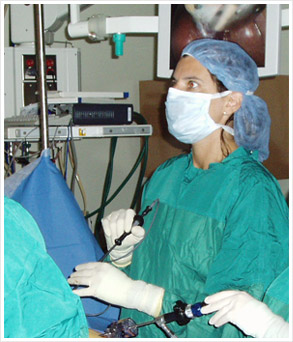Minimally Invasive and Laparoscopy Surgery
Dr. Ephraim McDowell who removed a huge ovarian tumor – without anesthesia performed the first documented successful abdominal surgery in 1809. Since then, medicine and the field of surgery has developed by leaps and bounds. Procedures and treatments once thought impossible are now common place. Research and technology provide ways and means to explore and create new frontiers in surgery. One such frontier, laparoscopy and minimally invasive surgery is available and widely used.
What is laparoscopy?

Laparoscopy is abdominal surgery through micro-incisions. This avoids a large incision, which is often through muscle, and diminishes the complications inherent to large incisions such as pain, infection and hernia. Gas is instilled into the abdominal cavity to create a balloon-like environment. A fiberoptic camera is placed through one of the small incisions, the instruments through the others, and the procedure is watched on video monitors. In general, the laparoscopic procedures are modeled around the same principles of open surgery and provide similar successful results and durability. This new, improved technique has expanded surgeons’ ability to offer patients a more rapid recovery, shorter hospital stay, quicker return to work and play and less postoperative pain.
What kind of surgery can be done laparoscopically?
Laparoscopic cholecystectomy, removal of the gallbladder, is one of the most widely known applications of laparoscopy and is now a routine procedure worldwide. Over the last five to ten years, more and more advanced procedures have been proven and perfected using laparoscopy. Some of the most promising and state of the art procedures are outlined below.
Abdominal wall hernia repair
Ventral incisional hernias (VIH) occur anywhere on the abdominal wall through a previous surgical incision. Unattended, VIH enlarge with time and pose a risk of incarceration and strangulation of intestines. That is, the bowel can get “stuck” in the hernia defect and cause a bowel obstruction and possible bowel injury. In general, these hernias need to be repaired. Traditional open repairs carry a high recurrence rate as well as concern for infection due to the usually large incision through already scarred tissue. In an effort to address these issues, the laparoscopic VIH repair was developed. The laparoscopic repair involves placement of mesh over the hernia defect from the inside – sort of like placing a patch on a punctured tire from the inside. The pressure from inside the abdomen actually aids in the repair. For this reason, patients often have little, to no, restraints on lifting after surgery. The five year data are highly encouraging - showing lower recurrence and infection rates. Once again, patients have a faster recovery and shorter hospital stay, especially for recurrent, multiple or very large hernias.
Groin hernia repair
Laparoscopic inguinal (groin) hernia repair was among the first to be developed with the advent of advanced laparoscopy. The recent data show the most improvement and encouraging results in patients with recurrent hernias, bilateral hernias or in patients requiring a quicker return to heavy lifting. The procedure involves placement of mesh, once again, from behind the hernia by approaching the defect under the tissue rather than cutting through the tissue to access the hernia.
Other procedures
Other less common but equally effective and successful advanced laparoscopic procedures include laparoscopic adrenalectomy (adrenal gland), laparoscopic splenectomy (spleen), laparoscopic nephrectomy (kidney), laparoscopic appendectomy, and laparoscopic colectomy (colon) for benign disease such as large polyps or diverticular disease.
The above information is meant to provide a general outline for these specialized advanced laparoscopic cases. As always, consult your doctor for further sources of information or particulars on each procedures.
SILS™ (Single Incision Laparoscopic Surgery): Surgery with the potential for no visible scars.
Please call 410-571-9499 for more information. We will be happy to address your questions and concerns.






